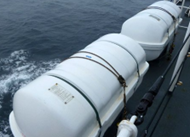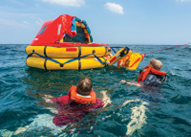1.5 Life Rafts
Life rafts are inflatable floating crafts used in case of emergency and abandon ship, particularly when accessing a lifeboat is impossible or unsafe.
Inflatable life rafts are located on each side of the deck.
They may be deployed by throwing overboard
with a line attached to the vessel. Pulling the line by dropping the closed raft
container triggers the pressurized bottle which inflates the raft. If the boat
sinks, the release opens and the raft floats. The connected end of the line has
a weak link so it can be pulled free.



Life rafts may also be inflated on deck and launched by davit, where the embarkation levels exceed 4.5m above the lightest seagoing condition of the vessel. In case of a freefall lifeboat, one of the life rafts must be davit-launched.
Inflatable life rafts must comply with the following requirements:
- The main buoyancy chamber shall be divided into at least 2 separate compartments, each fitted with a non-return valve for inflation. This ensures that if one compartment is damaged, the other can still provide sufficient buoyancy.
- The floor of the life raft shall be watertight and capable of being sufficiently insulated against the cold (inflation or other system). A warm floor is essential for the comfort and survival of occupants, especially in cold waters.
- The stability of a life raft shall be such that, when it is inverted, it can be righted on waves and in calm water by a single person. This is a safety feature, ensuring that the raft can be easily righted in an emergency.
- Life rafts must be fitted with stability bags having a capacity of 20 litres per person with a minimum total capacity of 220 litres. Stability bags help to keep the raft upright and prevent it from capsizing.
- Life rafts must be stowed in a container, rigid or non-rigid. The container protects the life raft when it is not in use.